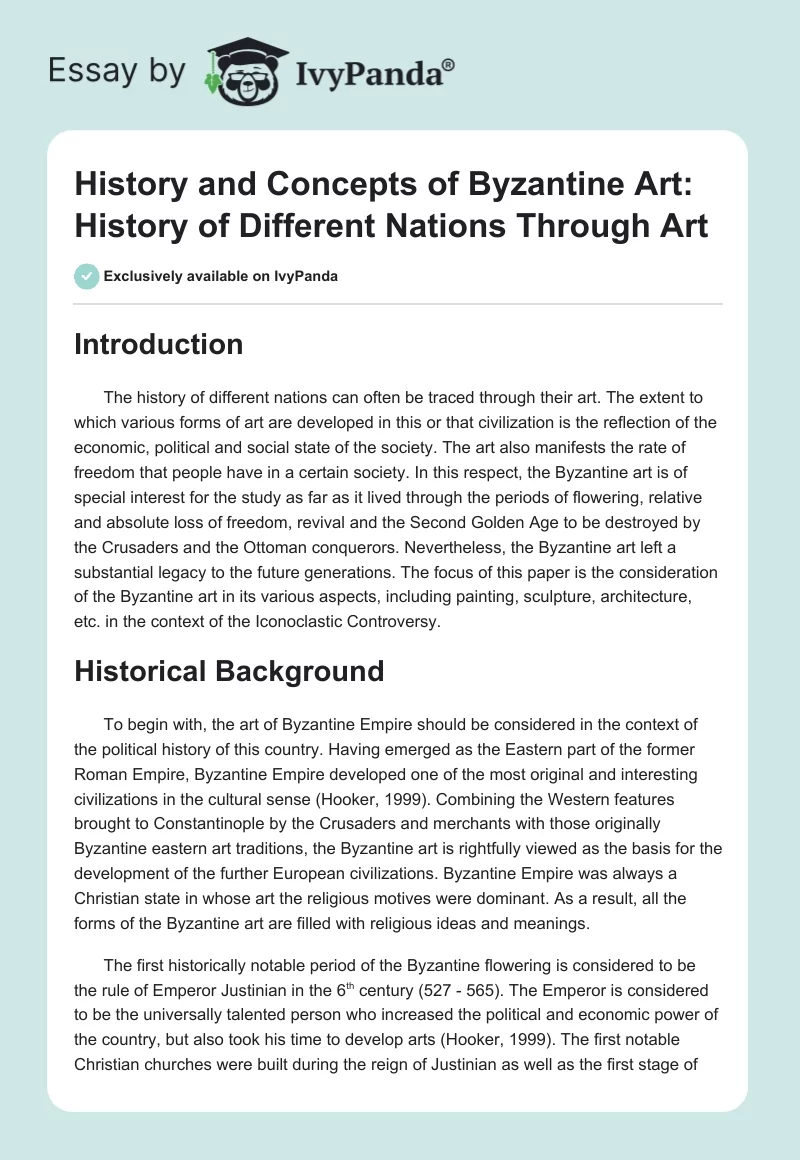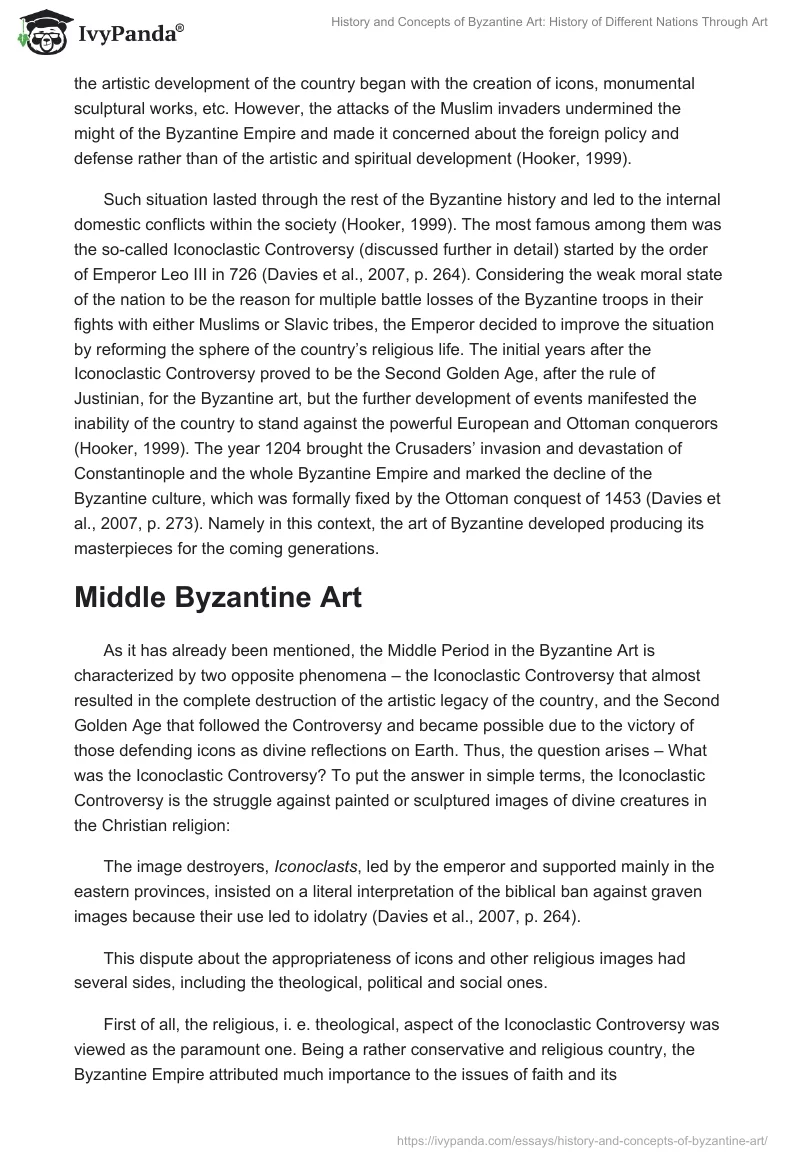Introduction
The history of different nations can often be traced through their art. The extent to which various forms of art are developed in this or that civilization is the reflection of the economic, political and social state of the society. The art also manifests the rate of freedom that people have in a certain society. In this respect, the Byzantine art is of special interest for the study as far as it lived through the periods of flowering, relative and absolute loss of freedom, revival and the Second Golden Age to be destroyed by the Crusaders and the Ottoman conquerors. Nevertheless, the Byzantine art left a substantial legacy to the future generations. The focus of this paper is the consideration of the Byzantine art in its various aspects, including painting, sculpture, architecture, etc. in the context of the Iconoclastic Controversy.
Historical Background
To begin with, the art of Byzantine Empire should be considered in the context of the political history of this country. Having emerged as the Eastern part of the former Roman Empire, Byzantine Empire developed one of the most original and interesting civilizations in the cultural sense (Hooker, 1999). Combining the Western features brought to Constantinople by the Crusaders and merchants with those originally Byzantine eastern art traditions, the Byzantine art is rightfully viewed as the basis for the development of the further European civilizations. Byzantine Empire was always a Christian state in whose art the religious motives were dominant. As a result, all the forms of the Byzantine art are filled with religious ideas and meanings.
The first historically notable period of the Byzantine flowering is considered to be the rule of Emperor Justinian in the 6th century (527 – 565). The Emperor is considered to be the universally talented person who increased the political and economic power of the country, but also took his time to develop arts (Hooker, 1999). The first notable Christian churches were built during the reign of Justinian as well as the first stage of the artistic development of the country began with the creation of icons, monumental sculptural works, etc. However, the attacks of the Muslim invaders undermined the might of the Byzantine Empire and made it concerned about the foreign policy and defense rather than of the artistic and spiritual development (Hooker, 1999).
Such situation lasted through the rest of the Byzantine history and led to the internal domestic conflicts within the society (Hooker, 1999). The most famous among them was the so-called Iconoclastic Controversy (discussed further in detail) started by the order of Emperor Leo III in 726 (Davies et al., 2007, p. 264). Considering the weak moral state of the nation to be the reason for multiple battle losses of the Byzantine troops in their fights with either Muslims or Slavic tribes, the Emperor decided to improve the situation by reforming the sphere of the country’s religious life. The initial years after the Iconoclastic Controversy proved to be the Second Golden Age, after the rule of Justinian, for the Byzantine art, but the further development of events manifested the inability of the country to stand against the powerful European and Ottoman conquerors (Hooker, 1999). The year 1204 brought the Crusaders’ invasion and devastation of Constantinople and the whole Byzantine Empire and marked the decline of the Byzantine culture, which was formally fixed by the Ottoman conquest of 1453 (Davies et al., 2007, p. 273). Namely in this context, the art of Byzantine developed producing its masterpieces for the coming generations.
Middle Byzantine Art
As it has already been mentioned, the Middle Period in the Byzantine Art is characterized by two opposite phenomena – the Iconoclastic Controversy that almost resulted in the complete destruction of the artistic legacy of the country, and the Second Golden Age that followed the Controversy and became possible due to the victory of those defending icons as divine reflections on Earth. Thus, the question arises – What was the Iconoclastic Controversy? To put the answer in simple terms, the Iconoclastic Controversy is the struggle against painted or sculptured images of divine creatures in the Christian religion:
The image destroyers, Iconoclasts, led by the emperor and supported mainly in the eastern provinces, insisted on a literal interpretation of the biblical ban against graven images because their use led to idolatry (Davies et al., 2007, p. 264).
This dispute about the appropriateness of icons and other religious images had several sides, including the theological, political and social ones.
First of all, the religious, i. e. theological, aspect of the Iconoclastic Controversy was viewed as the paramount one. Being a rather conservative and religious country, the Byzantine Empire attributed much importance to the issues of faith and its interpretation. Accordingly, the possibility of the development of idolatry threatened the supporters of Christianity with the most conservative beliefs. Their opponents, Iconophiles, defended the right of people to see the images of the divine creatures they praise.
Using the Neo-Platonic argument, the Iconophiles insisted on the equal importance of the image as the reflection of the divine creature it portrays: “Because Christ and his image are inseparable, the honor given to the image is transferred to him” (Davies et al., 2007, p. 265). Drawing from this, the defenders of icons claimed the Iconoclasts to be the heretics that did not admit the divine force of the image that portrays a divine creature line Jesus Christ, the Virgin Maria, or any of the saints or apostles. From the political point of view, the Iconoclastic Controversy was the attempt of the state to take the control over the Church that was rather powerful in the 8th century Byzantine Empire. In any case, the Controversy resulted in the serious damage to the Byzantine culture, which nevertheless revived to see the Second Golden Age.
However, to see the effects of the Iconoclastic controversy upon the Byzantine art, it is necessary to consider the major art forms that the Byzantine artists developed. First of all, icons constituted the bulk of the painting branch of art:
Icons generally took Christ, the Enthroned Madonna, or saints as their principal subjects and were objects of personal as well as public veneration. From the beginning they were considered portraits, for such pictures had developed in early Christian times out of Graeco-Roman portrait panels (Davies et al., 2007, p. 263).
The leading technique used by icon painters was the implementation of the mixture of encaustic with the hot was and pigment which allowed the icons, usually painted on panels or church walls, to preserve their clarity of image, brightness of color and quality of image representation.
Picturing the faces and bodies of the divine creatures and the Christian saints, the icons became the matter for the Iconoclastic Controversy as the suspected means of establishing idolatry in the Byzantine society. Nevertheless, the victory of Iconophiles, who managed to prove the equal importance of the icons and the actual saints they portray, impacted the production of icons positively spreading this type of Byzantine portrait to be used in churches, houses of ordinary citizens, in the battlefields like the defensive objects with the totemic powers, etc. At the same time, yet during the Iconoclastic Controversy, the secular art developed even more rapidly as the sphere of art not banned by Leo III. Among them, illustrated books including the Joshua Roll, David Composing the Psalms, and other can be mentioned. The major features of this branch of art were the visualization of the religious and mythological subjects and combining their characters and main ideas. For example, David Composing the Psalms displays the pictures of the biblical King David with the Greek nymph Echo and an abstract embodiment of Melody (Davies et al., 2007, p. 266).
In sculpture, the Second Golden Age brought the shift of the traditional forms and poses used in the groups depicted. If before the Iconoclastic Controversy the strict and calm figures, almost completely deprived of motion and facial expression were dominant, the Second Golden age changed this to the freer motions, postures and facial expressions. The topic of Crucifixion became rather popular which made the expression of the “restrained and noble suffering” (Davies et al., 2007, p. 270) into a dominant features of sculptural pieces and painting characters. All these forms of art developed rather rapidly during the 8th – 9th centuries making the Byzantine culture into of the prominent cultures of the early medieval world.
Conclusion
To make the respective conclusion, the Byzantine art left a substantial legacy to the future generations. Although it lived through the periods of flowering, relative and absolute loss of freedom, revival and the Second Golden Age to be destroyed by the Crusaders and the Ottoman conquerors, the masterpieces of the Byzantine art are still considered to be the manifestations of one of the most original cultures in the world. The Iconoclastic Controversy was the period when the art of the Byzantine Empire was under the threat of destruction, but it managed to revive and face the Second Golden Age dated as the late 8th – early 9th centuries. Icons, illustrated books, sculpture, and monumental architecture are all the examples of the Byzantine art that managed to survive the attempts to destroy it.
Works Cited
- Davies, Penelope J.E., Walter B. Denny, Frima Fox Hofrichter, Joseph F. Jacobs, Ann M. Roberts, and David L. Simon. Janson’s History of Art: The Western Tradition. Seventh Edition. New Jersey: Prentice Hall, 2007.
- Hooker, Richard. “The Byzantine Empire.” The European Middle Ages. 1999. World Civlizations.


